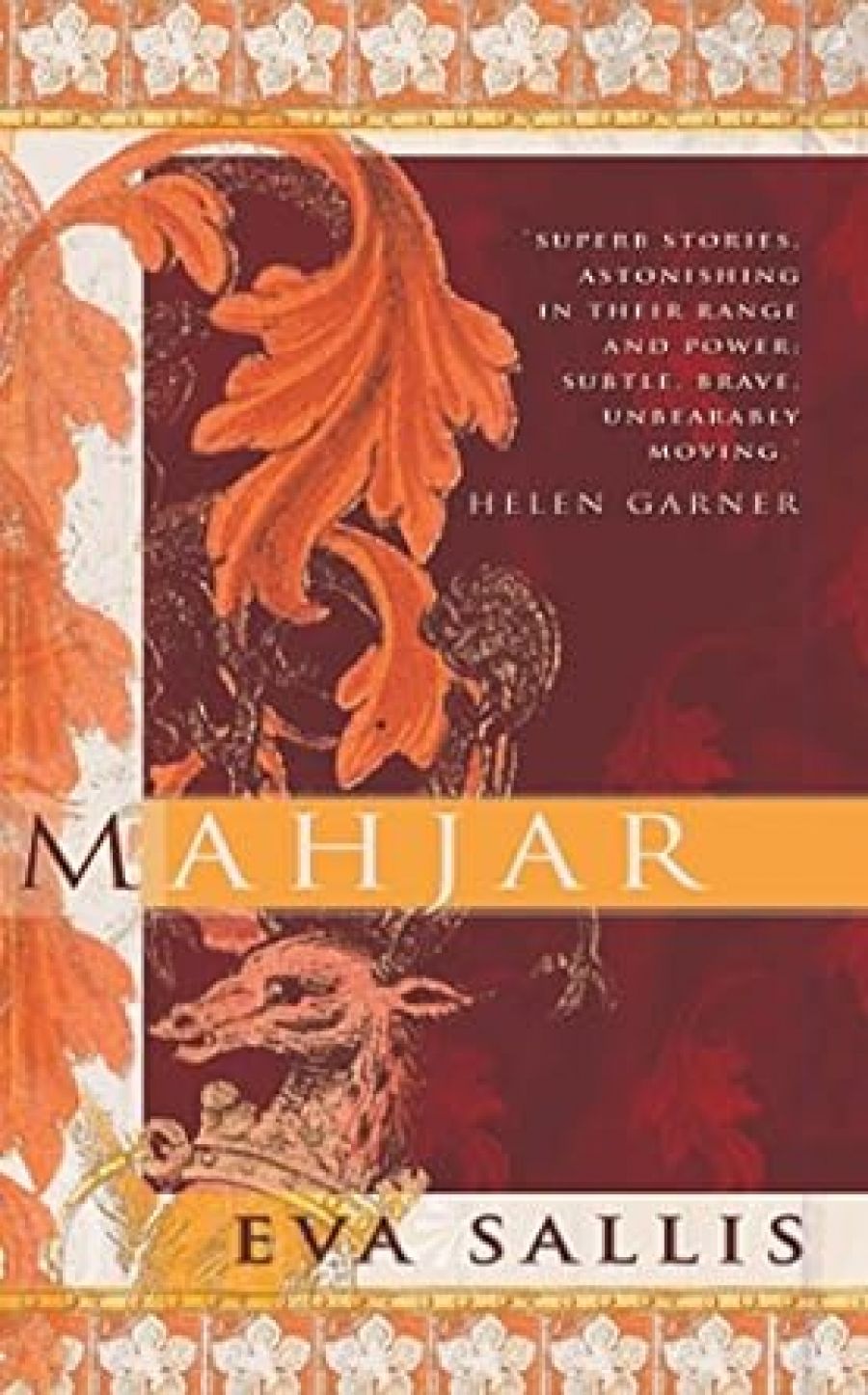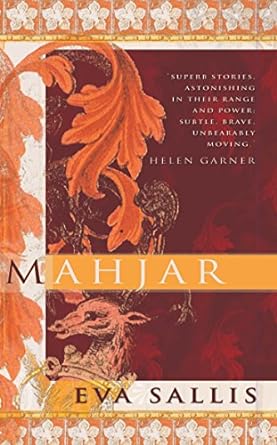
- Free Article: No
- Contents Category: Fiction
- Review Article: Yes
- Article Title: Look, No Snipers
- Online Only: No
- Custom Highlight Text:
The word ‘mahjar’, Eva Sallis informs us, ‘refers collectively to all the lands of Arab, most often Lebanese, migration’. Her third book of fiction is a slight volume composed of fifteen stories, divided into three sections. In deceptively simple prose and syntax, Sallis surveys the gamut of experiences affecting the displaced migrant. As in her previous novels, Hiam and The City of Sealions, a beguiling mixture of fantasy, fact, and fable make up the fabric of the book. With a PhD in comparative literature (Arabic and English), Sallis is well placed to oscillate between two cultures, and Mahjar is a perfect vehicle to showcase cross-cultural interactions.
- Book 1 Title: Mahjar
- Book 1 Biblio: Allen & Unwin, $19.95 pb, 180 pp
- Book 1 Cover Small (400 x 600):

Several of these stories have been published before, in various anthologies, but it makes sense to collect them, particularly as some characters weave in and out of different contexts, offering a more multi-layered account of their lives. As in any short story collection, some offerings are better than others. Mahjar is not immune from insubstantial filler material, but most of the stories belie their slimness by a depth of emotional impact. There is a preoccupation with the Middle Eastern diaspora, or, in Sallis’s term, the ‘Mahjar’ experience of the migrant in Australia. In the opening story, for instance, four friends set out on a country trip to Berri, admiring the ‘lovely, civilised new roads’ and marvelling that there are no ‘snipers to worry about and no roadblocks’. However, their paean to this great sunburnt land is rudely interrupted when they encounter a rogue kangaroo and realise that this fuzzy symbol of down under can be vicious. Sallis’s handling of the story is spiky and masterful. Instead of being overwhelmed by the marsupial, the quartet retaliates furiously. We are left with the ridiculous image of a roo being beaten to death by patent leather stilettos. In the space of a few paragraphs, the action moves from an idyllic car ride in the host country to violent confrontation with one of its native inhabitants. Yet, despite its bloody outcome, the story has a rather hopeful strain: the fact that these ‘New Australians’ can adapt and cope with adverse situations augurs well for their future in a new land.
Sallis also debunks the cliché of the demure Middle Eastern woman. Instead of hiding beneath their protective burkas, the women featured in Mahjar are not averse to wearing high heels and lipstick, and are quite given to venting passion and vitriol publicly. However, the conscious act of assimilation into the Australian way of life doesn’t necessarily mean self-abnegation. The plucky protagonist in ‘Zein’s Way’, for example, may capitulate to the prevailing dress code and be well versed in the Aussie vernacular, but she still maintains her own identity. Indeed, elsewhere in the book, there is a strong sense of the robust community of first- and second-generation migrants congregating for gossip and support in their artificially sculpted patch of ‘Little Lebanon’, somewhere in the heart of the suburbs.
Sallis’s prose is neither overblown nor flowery; the book draws its strength from the pared-down language, which, in its simplest form, takes on the narrative of traditional fairy tales (e.g. ‘The Tiger’ and ‘The Gazelle’). Most of the stories are set in an unspecified Australian town, with occasional casual references to Lebanon in the form of tanks, roadblocks, and pock-marked walls. The spectre of war is never far from the narrative, with the horror of loss culminating in the story ‘The Sea’, a powerful faction that seems to be a fictionalised account of the notorious ‘children overboard’ incident. Equally affecting is the poignant post-mortem reflection in ‘The Hafli’, in which recent Iraqi refugee Abd al-Rahman (who also appears in ‘The Sea’, where he loses his wife and child) is comforted by long-time refugees, ‘those who had lost Palestine, those who had lost Palestinians’.
In other stories, most notably ‘Ibtisam Had Four Sons’, ‘Muwashshah’, and ‘Music’, Sallis explores the generational and cultural gap between Lebanese parents and their recalcitrant, Australian-raised offspring. It’s a familiar tale of teenage rebellion, of naughty boys who ‘do drugs, alcohol and girls’, and of insubordination. Unable to confront their parents with the truth of their gallivanting ways, the boys seek atonement in subterfuge and lies. The intermingling of mixed blood is also canvassed, with Sallis observing the dynamics of interracial marriages and the mutual fear of the Other that arises from Lebanese-Australian couplings. She is particularly good at portraying the rumblings of familial discord and the aches of maternal pride and obsession.
From simple, humorous tales and Arabic fables, to thinly veiled socio-political commentary, Mahjar is an engaging collection of stories that appeals to head and heart. More importantly, however, it succeeds in demystifying some of the customs and beliefs of the Middle East, providing a warm and sympathetic treatment of its refugees and lifting the shroud from a group of people so misunderstood and maligned. At the very least, Mahjar provides a counterpoint to the generalisation and demonisation of asylum seekers and Muslim culture that still lingers in the media.


Comments powered by CComment